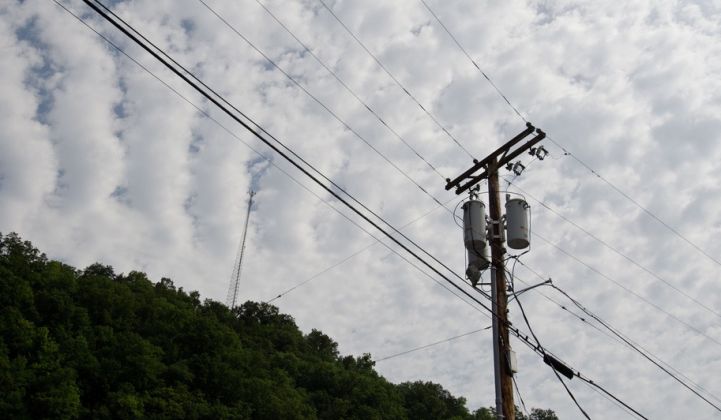Tantalus has landed a lot of municipal and cooperative utility customers interested in linking up lots of different smart grid communications technologies, from private mesh radio systems to cellular, WiMAX and fiber-to-the-home. It has also been expanding what it does with those networks, from connecting smart meters to managing demand response -- and now, controlling grid voltage itself.
That’s the gist of Tantalus’s new distributed conservation voltage reduction (DCVR) project announced Tuesday with Tennessee’s Morristown Utility Systems. It’s an interesting combination of two technologies not often seen together: smart meters connected by a high-speed fiber-to-the-home utility network, and devices that shape distribution grid voltages to increase efficiency.
Take it as one example of how the Vancouver, B.C.-based company is mixing and matching partners and technologies to serve the small utility market. North America has about 2,000 municipal utilities and about 900 electric cooperatives, with a combined 40 million or so customers to enable with smart meters and other smart grid technology.
We’ve seen smart grid giants like General Electric and SAIC form smart grid businesses specifically targeting that market, as well as new partnerships, like the ones between Calico Energy and Aclara and On-Ramp Wireless and ElectSolve, formed to tackle that target market’s needs for lower-cost, lower-complexity solutions to their problems.
Tantalus, in its turn, has migrated from offering its own private spectrum communications technology -- one that works well for serving utilities with lots of remote and rural customers -- to combining a host of partners’ communications under its own roof.
“We’re not setting out to sell something; we’re here to enhance existing assets,” Eric Murray, president and CEO, told me in an interview last month. In Morristown’s case, Tantalus is pulling data from smart meters and feeding it through the utility’s SCADA system to help grid equipment from vendor Efacec ACS maintain voltages in their proper range, he said.
This allows the utility both to run its distribution system more efficiently and, if needed, reduce the voltage to lower peak power demand. While other conservation voltage reduction (CVR) systems do pull data from smart meters for monitoring purposes, having meters connected to a high-speed fiber connection allows the Tantalus platform to put that data to use in seconds, Murray noted. The company is working with Efacec, Survalent and other companies on the distribution grid gear side, he said.
It’s not the only fiber-connected utility Tantalus is working with. The company is also a partner with Chattanooga, Tenn.’s EPB on that utility’s ambitious plan to connect homes to smart meters, TV and internet service. Tantalus is integrating with Alcatel-Lucent’s smart grid management system and S&C Electric’s distribution grid devices on that project, and has also built some demand response applications to run on the network, Murray said.
Both of these utilities get their power from the federal Tennessee Valley Authority, by the way, as do about seven other Tantalus utility customers. Murray said the company’s new DCVR system and demand response capabilities could be rolled out to those TVA customers as well. While fiber is too expensive for most utilities to use on a home-by-home basis, it can work for municipalities, states or other entities that can offer broader services over the same broadband pipe.
Fiber isn’t the only network Tantalus has used to enable demand response through smart meters, however. It’s also working with customers including Chatham-Kent Hydro and Saint John Energy in Canada and Northeastern REMC and Deep East Texas Electric Coop in the U.S. on similar projects, Murray said.
Tantalus’ partnership underway with Itron will offer it another set of meters to tap for demand response, Murray noted: Itron’s encoder receiver transmitter (ERT) meters. These previous-generation meters don’t maintain two-way communication with utilities, but rather send out regular radio 'pings' of data meant to be picked up by utility crews driving by in receiver-equipped vehicles.
Itron’s ERT meters make up the lion’s share of so-called automated meter reading (AMR) meters that came before two-way communicating smart meters caught on, and more than 60 million of them (electric, water and gas) have been deployed across North America. By linking its TUNet platform to Itron’s ERT meters, Tantalus will be able to read ERT signals from the communications nodes it deploys in a community, Murray said.
That, in turn, could allow utilities to roll out a demand response program that uses one-way radio or pager networks to turn down household power, then collect the ERT meter data to measure and verify that the load drop indeed took place, Murray said. In short, it’s a cheaper way for utilities to emulate the two-way functions of smart meters for demand response, without going out and replacing all their still-useful one-way AMR meters, he said.
The Itron-Tantalus partnership is also aimed at municipal utilities that manage gas and water as well as electricity. In January, Itron launched a version of its Sentinel smart meter that’s Tantalus-compatible, and already has a customer using them, fiber-equipped utility Jackson Energy Authority.
Of course, Itron has other partners working on linking ERT meters to two-way smart grid communications systems, along with plenty of other partnerships with the likes of Cisco that support its current OpenWay smart meter platform. So, indeed, do the other big smart meter vendors. We’ve also seen plenty of communications intermingling, most recently with Itron’s purchase of cellular smart meter player SmartSynch.
No doubt utilities both big and small will need smart grid systems that can manage multiple communications in an integrated fashion. Tantalus isn’t the only smart grid company promising simplicity, flexibility and low-cost integration as the path to success. But its expertise in its niche markets -- and the potential of its partnerships -- make the company a challenger worth watching.



